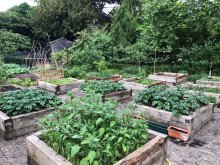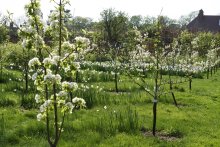Innovative gardening methods can help slow global warming by increasing carbon storage in soil and plants, and making green spaces more resilient to climate change. The Clare Border at King’s started life as an experiment in dry gardening, using a range of plants such as Echiums that require very little water to grow successfully in the increasingly arid seasons experienced in Cambridge, thereby minimising the need for irrigation. All green waste that comes out of the College is recycled, composted and spread back on the gardens, with woody materials chipped and reused.
Fellows Garden

The Fellows' Garden, on the west side of Queen's Road, was created in the early nineteenth century from space previously used as paddocks for the Provost's horses. It took another century for the garden to be opened to junior members of the College, and it is now occasionally open to the public under the National Gardens Scheme. The tranquil garden acts as a wildlife corridor and a wonderful green wedge coming right the way into Cambridge. The garden contains a number of island borders and specimen plants, as well as housing a variety of trees of scientific interest. All green waste that comes out of the gardens is recycled, including all woody materials which are chipped and reused.
Clare Border

The Clare Border at King’s started life as an experiment in dry gardening, using a range of plants that require very little water to grow successfully. The site is water limited, being a sunny and exposed south facing border within Cambridge’s low rainfall area. The border was established in 2016, taking as its inspiration the dry garden designed by Norman Villis at Cambridge University Botanic Garden, and more recently the gravel garden designed and installed by Beth Chatto at Elmstead Market, Essex.
The typically arid growing seasons experienced in Cambridge are being exacerbated by climate change. By introducing plants that require little water into this border we are minimising the need for irrigation, and are hopefully inspiring visitors to King’s to grow some of the plants they see here in their gardens at home.
The plants that really stand out within the border and are certainly most commented on are the two species of Echium that seem to wander from the banks of the Cam all the way up to the west end of the Chapel, along the ancient wall which separates King’s from Clare College. These giant buglosses are endemic to the Canary Islands, found a few hundred kilometres off the African coast. Keep an eye out for the solitary bees living in the old stone Clare border wall – this rare habitat supports declining pollinator species like Lasioglossum smeathmanellum.
Allotments

Our accommodation at Garden Hostel has a sizeable plot of allotments which are given over to students at the start of each academic year, comprising a series of raised beds alongside the main plot and the communal greenhouse. A 'no-dig' method is employed in order to not disturb the soil too much and foster soil development. In any given year you might find potatoes, onions, carrots and parsnips growing alongside maize, courgettes, flower sprouts, kohlrabi, rhubarb, celeriac, salsify, beetroot, turnips, beans, squashes and asparagus, with tomatoes, cucumbers and chillies getting going in the greenhouse. Companion planting with various herbs, and flowers such as nasturtiums and tagetes, helps to provide additional forage for pollinators whilst helping to ward off various pest species.
At the College's award-winning Passivhaus buildings on Cranmer Road, the landscape is also geared towards biodiversity and sustainability. A matrix planting scheme is in evidence with lots of herbaceous perennial plants, as well as another set of student allotments and fruit espaliers which not only give some privacy but also something to eat in the autumn.
The Orchard

Situated next to Garden Hostel, the orchard consists of more than thirty fruit trees of all different varieties, including apple, pear, plum, greengage, medlars and quince. It's a tranquil space that the students can roam in and pick the fruit when it ripens, acting as something of a safety valve from the pressures of academic study. The orchard's also home to our amazing Edwardian revolving summer house!






